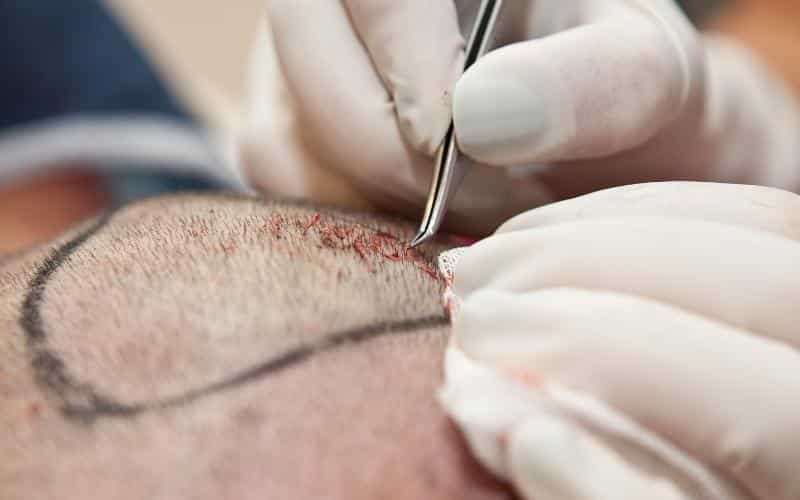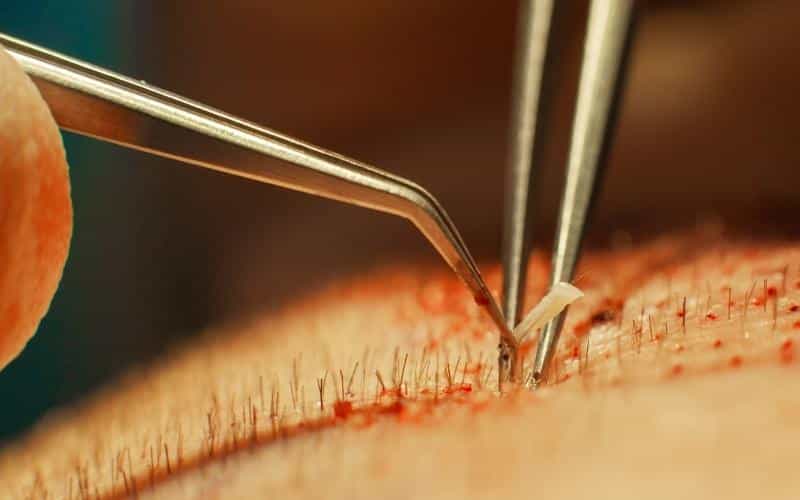Are hair transplants worth it? It’s a question many people ask when considering their options for restoring lost or thinning hair. Hair transplant procedures are becoming increasingly popular, but they can be expensive and complicated.
Before you decide if this is the right option for you, consider all of your alternatives and understand what the procedure entails so that you can make an informed decision about whether a hair transplant will truly be worth it in terms of cost, effort, and potential outcomes. This article will discuss the various aspects of hair transplants, from comprehending the procedure to preparing for surgery and ultimately evaluating if a transplant could be beneficial.
Table of Contents:
- What is a Hair Transplant?
- Is a Hair Transplant Worth It?
- Alternatives to Hair Transplants
- Preparing for a Hair Transplant Procedure
- Aftercare Following a Hair Transplant Procedure
- FAQs in Relation to Are Hair Transplant Worth it
- Conclusion
What is a Hair Transplant?

A hair transplant refers to the process of moving healthy hair follicles from one part of the scalp to areas that are thin or bald. It’s a solution for permanent hair loss, and the two main types of hair transplants are Follicular Unit Transplant (FUT) and Follicular Unit Extraction (FUE).
Follicular Unit Transplant (FUT)
A strip of skin with several hundred to several thousand hairs is removed from the donor site (back or sides of the head). Individual follicles are separated and implanted into tiny incisions in the recipient area (usually on top or front of the head).
- Duration: It takes longer as a strip of skin is removed and individual follicles are separated and implanted.
- Results: It often produces more dramatic and dense results, potentially more suitable for extensive hair loss.
Scarring: This may leave more noticeable scarring, especially at the donor site where the strip of skin is removed.
Follicular Unit Extraction (FUE)
Individual follicles are extracted directly from donor sites using a small punch tool. One graft is removed at a time without leaving any linear scarring behind. Harvested follicles are placed into tiny incisions in the recipient area, where they grow new strands.
- Duration: Generally shorter, as individual follicles are extracted one at a time.
- Results: It can provide natural-looking results, but success might depend on the skill and expertise of the surgeon.
- Scarring: Provides less noticeable scarring, as individual grafts are removed without leaving linear scars.
Considerations Before Committing to a Hair Transplant
By understanding these aspects of hair transplant procedures, individuals can make informed decisions that best suit their needs and preferences.
- Effectiveness: A hair transplant can effectively address permanent hair loss by transferring healthy follicles.
- Costs and Potential Risks:
- It’s crucial to understand the financial commitment and potential health risks.
- Carefully weigh the pros and cons before making any decisions.
Is a Hair Transplant Worth It?
When mulling over a hair transplant, the monetary expense is an essential point to consider. The cost of the operation will depend on how much hair has been lost and which method is selected. Generally speaking, larger transplants are more expensive than smaller ones. Other than the surgery itself, you may have to factor in other outlays such as pre-operative tests and drugs or post-treatment maintenance like follow-up visits or scalp therapies. It is important to research all available options before making a decision about whether or not a hair transplant is worth it for you financially.
Though uncommon, hair transplant procedures may involve infection, scarring, bleeding, and nerve damage. Thus, it is essential to assess the potential risks against any benefits when considering this procedure. While these complications are rare when performed by an experienced surgeon who uses modern techniques and equipment. They can still occur so it’s important to weigh this risk against any potential benefits when deciding if a hair transplant is right for you.
Quality of Results and Surgeon Experience:
The quality of results from your hair transplant largely depends on your surgeon’s experience level, so ensure they have ample experience performing successful procedures to get optimal results from your treatment. Additionally, ask questions about the technique(s) used during surgery (such as FUE or FUT), their success rate compared to other surgeons in their field, and how many years they have been practicing specifically doing hair transplants before committing to having them perform yours.
Quality of Results
- Long-lasting: Most patients report enjoying results lasting between 10 to 15 years, meaning no need for further costly treatments.
- Permanent Solution: Investing in a hair transplant is often worthwhile overall since its effects tend to be permanent, unlike alternatives like medication or topical solutions that require ongoing maintenance.
Surgeon Experience
- Crucial for Success: The surgeon’s experience level, technique(s) used, success rate, and years of practice in hair transplants are essential to achieving optimal results.
Careful Consideration: Make sure to inquire about these factors before committing to the procedure, ensuring that your chosen surgeon is well-qualified to perform the transplant.
Alternatives to Hair Transplants

For those looking for a permanent hair loss solution, hair transplants are one option. Nevertheless, other treatments exist for those looking to combat hair loss. Medication options for treating hair loss include minoxidil (Rogaine) and finasteride (Propecia). Topical minoxidil, available without a prescription, may aid in hair regrowth by enhancing circulation to the scalp and providing nourishment for healthy follicles.
Finasteride, a prescription oral medication, inhibits the hormone associated with male pattern baldness to forestall additional hairline thinning. Non-surgical approaches, such as laser treatment or PRP injections, may be employed with medication to retard or impede hair loss. Laser therapy stimulates cell metabolism, which encourages new hairs to grow. At the same time, platelet-rich plasma injections involve taking a sample of your blood and injecting it into areas where you’re experiencing thinning or balding patches on your scalp. These treatments can provide short-term results but may need multiple sessions before seeing any real change in your appearance.
Evaluating the potential benefits and drawbacks is essential before deciding which hair transplant alternative to pursue. Here is a table summarising some common alternatives:
| Alternative | Method | Pros | Cons |
| Minoxidil (Rogaine) | Topical treatment to enhance scalp circulation | Non-prescription aids in hair regrowth | It may require ongoing use |
| Finasteride (Propecia) | Prescription oral medication inhibiting hormone causing male pattern baldness | Targets the underlying cause of hair loss | Prescription needed. Potential side effects |
| Laser Treatment | Stimulates cell metabolism for hair growth | Non-invasive encourages new hair growth | Short-term results may need multiple sessions |
| PRP Injections | Injecting platelet-rich plasma into thinning or balding areas | It uses your blood and can enhance the appearance | Short-term results may need multiple sessions |
Preparing for a Hair Transplant Procedure

Following these steps, you can prepare for a successful hair transplant and understand what to expect during and after the surgery. Ensuring clear communication with your surgeon and adhering to all provided instructions are key to optimizing results and minimizing risks.
Step 1: Schedule a Pre-Procedure Consultation
- Meet with your surgeon to discuss your medical history, hair loss pattern, expectations, and potential risks or complications.
- Your surgeon may take photographs to document the area before and after the procedure.
Step 2: Disclose Medications and Supplements
- Inform your surgeon about any medications or supplements you are taking, as they could impact the success of the transplant.
Step 3: Undergo Medical Examinations
- Complete any required medical examinations, such as blood tests, to ensure no health issues could hinder recovery.
Step 4: Follow Pre-Operation Instructions
- Before the operation, adhere to your surgeon’s specific guidelines, including dieting or fasting instructions.
- Understand when to resume normal activities post-surgery, like exercising or swimming.
Step 5: Avoid Certain Products
- Follow your surgeon’s advice on avoiding certain products, such as alcohol, leading up to the procedure, as they can impede healing and increase infection risks.
Step 6: Adhere to Instructions for Optimal Results
- Strictly follow your surgeon’s guidelines before and after the operation for the best outcome.
Step 7: Aftercare
- Take precautions to avoid infection and manage pain, swelling, and redness after the procedure.
Aftercare Following a Hair Transplant Procedure
Following your surgeon’s instructions post-procedure is essential for optimal hair transplant results, including taking prescribed medications and avoiding activities that may cause trauma or infection. Proper aftercare is vital to manage pain, swelling, and redness and prevent potential complications. Adhering to a disciplined routine, such as applying cold compresses, taking prescribed medications, and maintaining proper hygiene, can significantly affect healing. Avoiding infection is paramount for successful healing and long-term results, so it’s essential to follow all the guidelines provided by your healthcare provider.
Here’s a table summarising key aftercare instructions:
| Aftercare Aspect | Instructions |
| Medications | Take prescribed antibiotics and anti-inflammatory drugs as directed by your doctor. |
| Pain Management | Apply cold compresses for 10 minutes; use prescribed or OTC painkillers. |
| Scalp Hygiene | Wash gently with mild soap and warm water twice daily; avoid styling products initially. |
| Avoid Trauma/Infection | Refrain from activities that may cause trauma; avoid picking at scabs or scratching. |
FAQs in Relation to Are Hair Transplant Worth it
Are hair transplants really worth it?
For those struggling with hair loss, a hair transplant can be an effective solution that may offer lasting results when performed by a knowledgeable and experienced practitioner. The process includes taking hair follicles from an area of the scalp with plentiful growth and transferring them to areas that have thinning or baldness. For optimal results, it is essential to seek out a skilled professional with expertise in this area. It is important to research different providers before making any decisions as outcomes will vary depending on skill level and expertise.
What is the downside of a hair transplant?
For those seeking to address hair loss, a hair transplant or restoration procedure can be an option. However, it is important to consider the potential risks associated with such treatments. The most common risks include scarring, infection, numbness, or tingling of the scalp. Also, poor growth of transplanted hairs, and an unnatural appearance due to uneven distribution of grafts. In addition, these procedures require multiple sessions over several months in order to achieve desired results which may be costly and time-consuming. Ultimately, success cannot be guaranteed as outcomes may differ depending on the individual’s age and overall health.
What is the success rate of a hair transplant?
The success of a hair transplant largely depends on the type and skill of the procedure, as well as age and health status. Generally, hair transplants are successful for most patients, often achieving the desired outcome. Follicular unit extraction (FUE) is one of the more popular methods used today and has an average success rate between 85-95%. In some cases, it can be even higher. Strip harvesting techniques also have good results but are slightly less successful than FUE at around 80-90%. Ultimately though, these procedures offer excellent solutions for those suffering from hair loss or baldness.
Is a men’s hair transplant worth it?
Yes, a men’s hair transplant can be worth it. The procedure is minimally invasive and offers permanent results for those who are suffering from hair loss or balding. It can restore the look of fullness to areas that have been affected by thinning or balding, providing natural-looking results with minimal downtime after the procedure. Hair transplants also offer long-term benefits as they provide permanent solutions to hair loss issues while allowing patients to maintain their desired style without having to worry about ongoing treatments.
So in the End, Are Hair Transplant Worth It?
In summary, hair transplants can be a viable solution for those wanting to restore their locks and increase self-assurance. While the cost of the procedure may seem high initially. It is worth considering in terms of long-term savings on expensive treatments like wigs or toupees.
With proper preparation and aftercare following the transplant, patients should expect natural results that last for years with minimal maintenance required. Ultimately, whether or not a hair transplant is worth it depends on individual circumstances. What works best for one person might not work as well for another.
If you’re considering a hair transplant, take the time to research and understand all of your options. Make sure that the procedure is worth it for you before committing to any particular solution.
Best Hair Transplant
1970 S. Prospect Ave., Suite 2
Redondo Beach, CA 90277
(213) 403-0455
https://www.google.com/maps?cid=9280610872186794918
To ensure your ease of mind, you can view our customer recommendations HERE. Furthermore, you can also see our Google reviews and Yelp reviews. We can’t wait to help you start restoring your lost hair.
